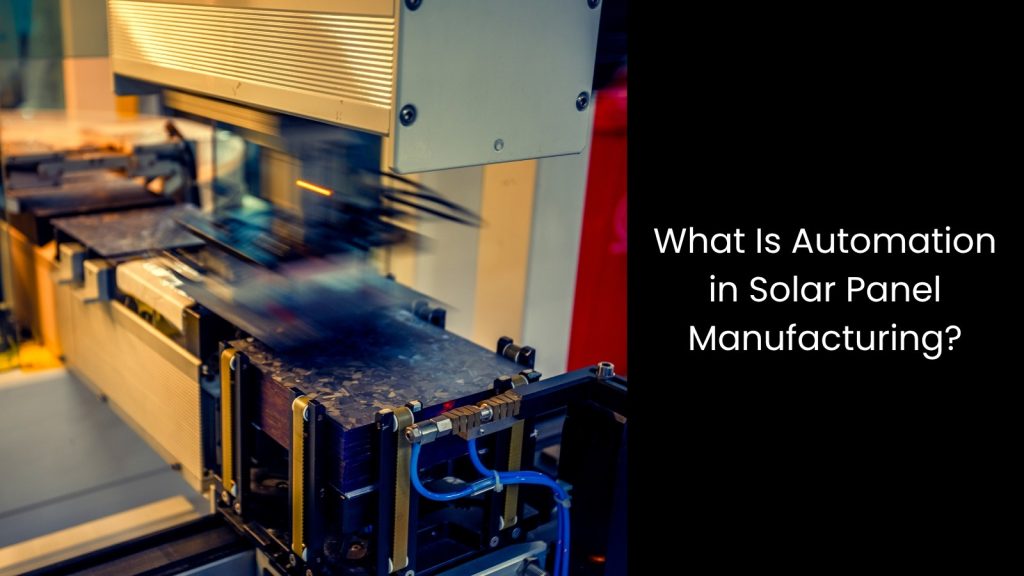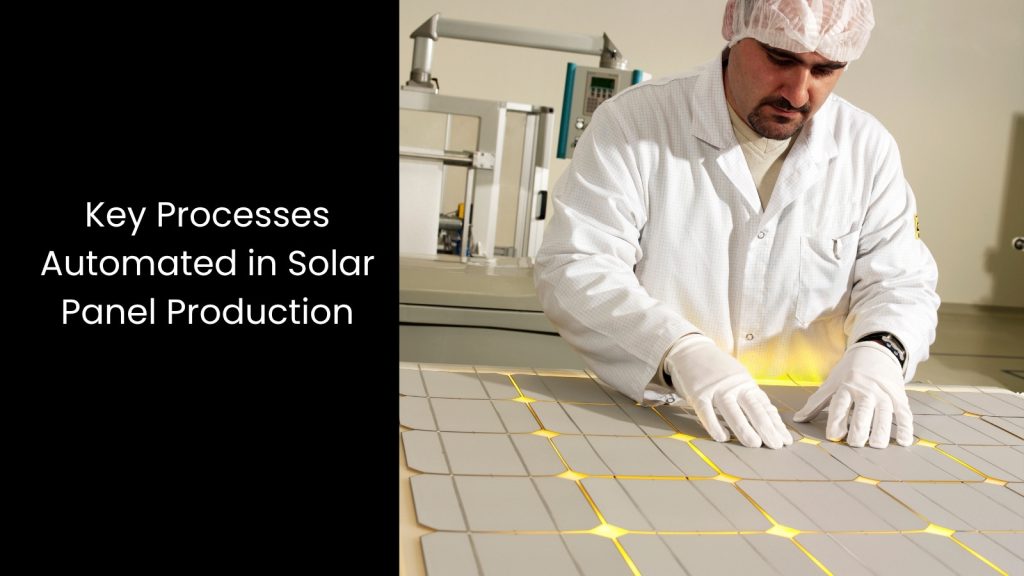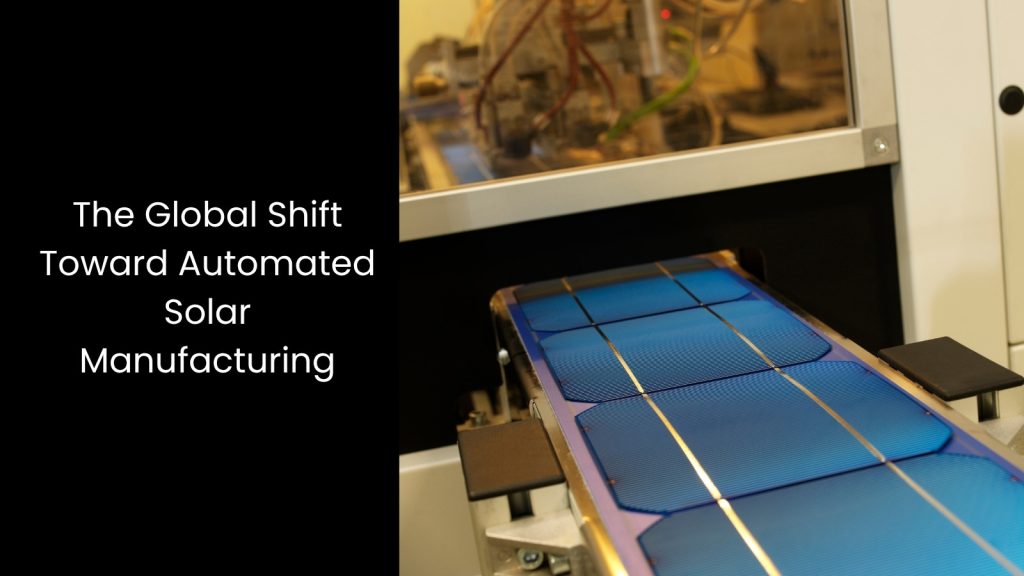Let us explore how automation boosts precision, reduces cost, and increases output in solar panel manufacturing.
We will uncover
- What Is Automation in Solar Panel Manufacturing?
- Key Processes Automated in Solar Panel Production
- Benefits of Automation in Solar Panel Manufacturing
- Challenges of Integrating Automation in Solar Manufacturing
- Impact of Automation on Cost Reduction and Productivity
- Automation Technologies Shaping the Future of Solar Manufacturing
- How Automation Supports Sustainability in Solar Panel Production
- The Global Shift Toward Automated Solar Manufacturing
- Cerexio Industry 4.0 Powered Solutions for Solar Panel Manufacturing
- Automating Solar Panel Manufacturing Easily with the Right Technological Integration
What Is Automation in Solar Panel Manufacturing?

- This means using machines and smart systems to handle tasks that people once did by hand.
- In this fast-moving industry, companies set up an automated production line to build panels faster and with fewer mistakes. This setup includes robotics for placing parts, AI for quick decision-making, and PLCs (programmable logic controllers) to manage equipment smoothly.
- Also, automated inspection systems spot flaws early, saving time and money.
- These tools work together to boost speed and accuracy during the solar panel assembly automation process. As solar energy grows more popular, automation helps meet demand without losing quality, making the whole production run smarter and more reliable.
Key Processes Automated in Solar Panel Production

Silicon Wafer Cutting and Cleaning
High-speed saws and laser tools glide through silicon blocks, slicing them into perfect wafers with automated wafer cutting rigs that prevent cracks and waste. Next, brush stations and ultrasonic baths scrub away dust, while robots flip each piece for shine. Clean wafers move forward, and the line primes them for magic in later steps ahead.
Soldering and Cell Interconnection
As another thing, robotic arms kick into gear for automated cell soldering, pressing heated tips onto silver busbars with millimetre accuracy, so every join carries current without hiccups. Plus, conveyor belts sync perfectly, lining cells edge to edge, while vision systems correct misalignment on the fly. Finished strings slide outward, ready to link in larger, power-pumping matrices within modules.
Panel Lamination and Framing
Sheets of EVA film, glass, and cell strings enter an automated panel lamination chamber where vacuum pumps pull out bubbles and heated platens fuse layers in one smooth run. Sensors watch temperature and pressure every millisecond, guarding against warps. Downstream, robots snap aluminium rails into place, tightening fasteners so each frame stays square outside reliably.
Quality Inspection and Testing
Before shipping, strings face electroluminescence cameras that reveal hidden cracks like X-ray eyes, then flash testers hammer them with simulated sunlight during automated solar panel testing. Software compares voltage curves against strict limits, flagging weak cells instantly. Finally, robots flex panels, splash water, and shake them on vibration tables, ensuring tough, street-ready performance every time.
Benefits of Automation in Solar Panel Manufacturing

Higher Efficiency and Throughput
As robotic arms and systems move in perfect sync, factories push out more panels in less time. This boost in solar manufacturing efficiency helps meet rising global demand. Companies no longer wait days to reach targets; they hit them fast.
Since machines do not get tired or distracted, everything flows better. So, with an automated production line, production never skips a beat. Manufacturers can plan bigger batches, reach delivery goals faster, and scale operations with confidence, knowing speed does not hurt performance.
Improved Consistency and Product Quality
Robots cut, solder, and test with exact precision, making sure nothing slips through the cracks. This kind of consistency keeps product quality high and customer complaints low. With fewer mistakes, fewer panels need repairs or rework.
That is where one of the best automated production benefits shows up reliability. Even under pressure, automated machines stay sharp. You can get peace of mind because you know every solar panel meets high standards without second-guessing or sudden surprises.
Lower Labour Costs and Reduced Human Error
Automation cuts out those mistakes and saves money on labour. Robots do not take breaks, call in sick, or misplace parts. They stay focused every second. This helps reduce hiring needs and training costs too.
Less human error means smoother runs, fewer damaged materials, and less waste. This is how businesses gain the edge they need to stay competitive, especially when solar manufacturing efficiency counts. So, instead of constantly fixing errors, manufacturers can focus on smart planning and high-level tasks that keep operations strong and moving forward.
Shorter Time-to-Market
Machines take hours off each production step, helping brands roll out new panels before the competition. This quick pace gives businesses a serious head start. With an automated production line, the process runs smoothly, from raw materials to final testing.
Every task gets handled quickly and accurately, so timelines stay on track. When speed matters, automation answers. It turns tight deadlines into doable goals, helping teams deliver products when customers need them.
Challenges of Integrating Automation in Solar Manufacturing

- Solar factories tend to face high upfront costs since installing robotic arms, AI systems, and smart sensors for automation does not come cheap and needs serious budgeting from day one.
- Manufacturers also deal with a need for a skilled workforce because not everyone knows how to run or fix advanced machines, and training the right people takes time and money.
- The tough part hits during automation system integration, as connecting new machines with older setups often leads to tech hiccups, delays, and extra headaches across the line.
- Many face hidden solar plant automation challenges when machines break down or need updates, which stalls production unless expert technicians step in fast.
Impact of Automation on Cost Reduction and Productivity

- Factory owners lower solar panel production costs over time as machines speed things up, cut down mistakes, and work without breaks or overtime pay.
- Teams see strong automation ROI since the upfront spend turns into long-term savings, as equipment keeps working hard for years while labour and waste costs shrink.
- With smart machines handling jobs precisely, plants create less scrap and use power more wisely, which helps reduce waste and lower energy bills every month.
- As demand climbs, factories boost automated manufacturing productivity fast because automation systems scale up smoothly without hiring more workers or stretching the current setup too thin.
Automation Technologies Shaping the Future of Solar Manufacturing

- Artificial Intelligence and Machine Learning – AI in solar panel manufacturing helps machines learn from past data and spot problems before they grow. These smart systems adjust steps in real time, which keeps the process smooth, fast, and highly accurate every time.
- Predictive Maintenance – Predictive tools track machine health 24/7 and warn teams before parts wear out. This method avoids sudden breakdowns, saves time, and keeps AI in solar panel manufacturing running without stopping or wasting materials.
- Smart Factories – This technology uses connected machines and real-time data to run smoother operations. They boost quality checks and speed up tasks, which makes them a big part of Industry 4.0 solar production across modern solar plants.
- Industry 4.0 integration – Industry 4.0 solar production brings together sensors, cloud systems, and robotics to help factories think and act smarter. This setup lets manufacturers make better decisions fast and adapt their production lines without slowing anything down.
How Automation Supports Sustainability in Solar Panel Production

- Minimising Material Wastage
- Energy-Efficient Operations
- Support for Green Manufacturing Standards
The Global Shift Toward Automated Solar Manufacturing

- The global solar automation trends show rapid growth as factories in Asia, Europe, and the U.S. race to adopt smarter machines and AI-driven systems.
- In Asia, large-scale manufacturing pushes fast innovation, while Europe focuses on precise, clean production methods.
- The U.S. blends both speed and quality to stay competitive. This shift in the solar industry automation growth helps boost production capacity and lowers costs, making renewable energy more accessible worldwide.
- As automated systems spread, they help meet the rising demand for clean power and speed up the move away from fossil fuels, powering a greener future for all.
Cerexio Industry 4.0 Powered Solutions for Solar Panel Manufacturing

Cerexio Industry 4.0-powered software solutions connect machines and data seamlessly, helping solar manufacturers automate production lines with real-time monitoring and smart controls. This next-level innovation improves efficiency and reduces downtime in solar panel manufacturing processes.
Automating Solar Panel Manufacturing Easily with the Right Technological Integration

With smart technological integration, automating solar panel manufacturing turns from a challenge into an opportunity. This shift boosts efficiency and cuts costs beyond doubt. It helps manufacturers stay ahead in a world that demands faster, greener energy solutions every single day.
